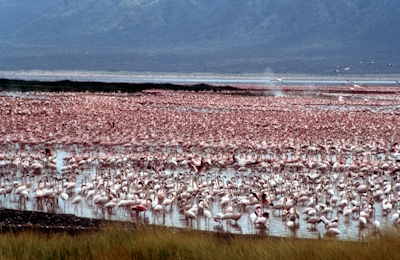Kenya Lake System

The Kenya Lake System in the Great Rift Valley consists of three soda lakes in the valley basin, known for their high concentration of Lesser Flamingo.
Lake Elementaita, Lake Nakuru and Lake Bogoria are shallow, alkaline, and are hydro-geologically connected through sub-surface seepage of water. The alkalinity of the three lakes supports the abundant growth of the green algae, which is the food of the Lesser Flamingoes, which congregate in the lakes in great numbers, and also attract breeding Great White Pelicans and migratory birds.
Community Perspective: Due to frequent flooding, the number of flamingoes in the lakes has been greatly reduced. The active and regular geysers and volcanic fumaroles at Lake Bogoria are worth visiting, while Lake Nakuru NP is proud of its black and white rhinos.

Map of Kenya Lake System
Community Reviews
Els Slots

It’s a miracle that this WHS is not In Danger, or that this issue is not being discussed. Since approximately 2015, the Kenyan Lake System has experienced severe flooding. The causes are not yet fully understood, but higher annual rainfall, degradation of the surrounding land due to deforestation and urbanization, and even possibly ‘closing’ of the tectonic plates under the Rift come into play. The floodings keep the flamingoes away from their once favourite habitat as they cannot wade in deep waters and the level of water salinity has changed as well. All 3 criteria that make up the Lake System’s OUV are at least partly related to those flamingoes (“the single most important foraging site for the Lesser Flamingo in the world with about 1.5 million individuals moving from one lake to the other”), and these numbers simply are not present anymore. To make matters worse, the smallest of the included lakes, Elementaita, seems already beyond repair according to IUCN in its Outlook 2020 because of uncontrolled development of its surroundings and the partial loss of Ramsar conservation status.
Kenya has submitted a State of Conservation report of the Lakes to this year's WHC, and with funding from the Dutch government hopes to fulfill all recommendations which it hasn’t been able to accomplish on its own for the past decade (the additional funding is 45k USD, which to me seems like a drop in the ocean).
I visited the area via a half-day private safari in Lake Nakuru National Park. The city of Nakuru now lies right at the edge of the park, so it doesn’t take a lot of effort to get there. Just behind the gates, it already becomes clear what effects the flooding has had on Lake Nakuru. A forest of dead trees is standing all along the shoreline, and even some electricity masts are now inside the lake. The park authorities had to create a new road as well to accommodate visitors. And it isn’t possible anymore to do a full loop by car around the lake, we got to about 60% and then turned around.
There aren’t many roads to follow in the park, so it is recommended to visit on a weekday, as it will get crowded on the weekends with Kenyan day trippers. All animals are clearly used to people driving by quite closely, even the usually so skittish Impalas didn’t blink an eye. With the flamingoes mostly gone, the pelicans are now the major species at the lake. On land, the stars are the Rhinos. Lake Nakuru NP has both white and black rhinos – they were introduced here in 1984 and have thrived since the park is fenced and there is no poaching. They are easily seen and often move around in small groups. Other notable sightings during my game drive included some “whitesocked” Rothschild’s giraffes and a sleeping male lion.
The overall scenery has its ups and downs – there are plenty of boring stretches, but especially at the lakeside, also a few excellent ones. My best experience of the Great Rift Valley, however, had been the day before, when my matatu from the Mount Kenya area to Nakuru launched itself at breakneck speed into this depression.
Lake Nakuru National Park is a ‘Premium Park’ within the Kenyan Park system, a status that only Amboseli holds as well. This comes with a hefty 60 USD entry fee for foreigners. Now I am not the one to complain about the pricing of natural sites when part of the money goes to conservation. But something is “off” here. The Premium parks are considered to have “higher quality and superior facilities”, but Lake Nakuru National Park does very poorly on our WHS Visitor Commandments scorecard. There’s no visitor center or any other information available on site about its value, the entrance fee is too high, and (of course) there’s no WH Plaque. The Main Gate entrance is probably even less glamorous than that of the minor Ngare Ndare Forest: it’s just a shack, and I felt sorry for the woman who had to sit there all day to check the (online) tickets. I saw no map of the park, and there were no checks conducted on whether we were bringing in single-use plastics such as plastic water bottles (which are forbidden in all Kenyan parks).
Read more from Els Slots here.
Patrik
I visited Lake Elementaita in March 2019 as this is the easiest lake to get to without paying high entrance fees and/or hiring a 4WD. I tried to go to Lake Nakuru as well with the National Park bus tour as well but after waiting for two hours in the bus at Nakuru bus station, only 10 passengers turned up which was not considered enough to run the bus.
Lake Elementaita I could visit by just getting off a matatu from Nakuru and then I walked down from the main road. I entered through a hotel gate and the friendly guard let me through, asking for a small fee if I happened to come back via the same path.
The alkaline gives a pretty reflection of the sun in the water, especially in late afternoon. Alongside the shore, the mineral deposits look interesting, with cracks running along it. I walked along the shore for perhaps five kilometers and encountered a few shepherds with their sheep, who were very kind and curious. I saw just a few flamingos in the lake in the distance, maribu storks are more abundant.
When the sun started setting, I walked back to the main road to wait for a matatu back to Nakuru which materialized within minutes.
Solivagant

Across the years since my first visit to Kenya in 1975 we have visited each of the 3 inscribed lakes. The photo is of Lake Bogoria and our visit there in 1991 is the one we remember best – for the flamingos of course, but also for the active and regular geysers and volcanic fumaroles and, finally, the road to get there!! We had rented a 4x4 and were rough camping. The so-called “road" we took into the lake from the south (we wanted the more remote southern camp site) was VERY boulder strewn with sharp volcanic rocks and we acquired punctures in 2 different tyres at the same time. Unfortunately we only had 1 spare wheel and no air pump! Ah well, all part of the “adventure”! Unless they have improved the road we recommend taking the northern entrance. Flamingos move around and couldn't, even in those days, be guaranteed in large numbers at all sites but we were pleased with the numbers when we were there – if you can only visit one lake try to find out before hand which has flamingoes at that time. From what we saw, Bogoria didn’t really offer much else in the way of wildlife viewing beyond birds – Nakuru on the other hand is presented as more of general “Wildlife park” with a wide range of (re-)introduced mammals including Lion, Rhino and Leopard. I remember it as somehwat “zoo-like” compared with e.g the Mara and Samburu, as it is situated just down the road from the busy town of Nakuru (pop 300k).
In 2008 we visited the rift valley alkaline lakes of Ethiopia (see my review of Abijatta-Shalla ). Ethiopia’s late 20th century history resulted in significant and possibly irreversible damage to those lakes which it had tried unsuccessfully to inscribe as early as 1981. It is good that Kenya had as of 1991 “done the necessary” to preserve its own. Let us hope it stays that way - A visit to see the massed Flamingos at one or other of these lakes is worth fitting in if you can whilst in Kenya.
Community Rating
- : MaYumin Alberto Rodriguez Gutierrez Ludvan
- : Eric PK Afshin Iranpour George Evangelou David Marton PabloNorte M.HATADA Richard Stone JobStopar Riomussafer Carlos Sotelo Piotr Wasil
- : Zoë Sheng GithaK
- : Els Slots Richardleesa Monica66 Rvieira Laurine Yongcheng Liu
- : Solivagant Joyce van Soest Randi Thomsen Thomas van der Walt Deffra
- : Svein Elias
Site Info
- Full Name
- Kenya Lake System in the Great Rift Valley
- Unesco ID
- 1060
- Country
- Kenya
- Inscribed
- 2011
- Type
- Natural
- Criteria
-
7 9 10
- Categories
- Natural landscape - Rivers, Wetlands and Lakes
- Link
- By ID
Site History
2011 Inscribed
2001 Referred
Referral at Bureau meeting as Rift Valley Lake Reserves: to make Lake Elementaita a protected area and completion of management plans for all three lakes.
Site Links
Unesco Website
Official Website
In the News
Connections
The site has 25 connections
Ecology
Geography
Human Activity
Timeline
Visiting conditions
WHS on Other Lists
World Heritage Process
Visitors
104 Community Members have visited.
The Plaque
No plaque has been identified yet for this site.